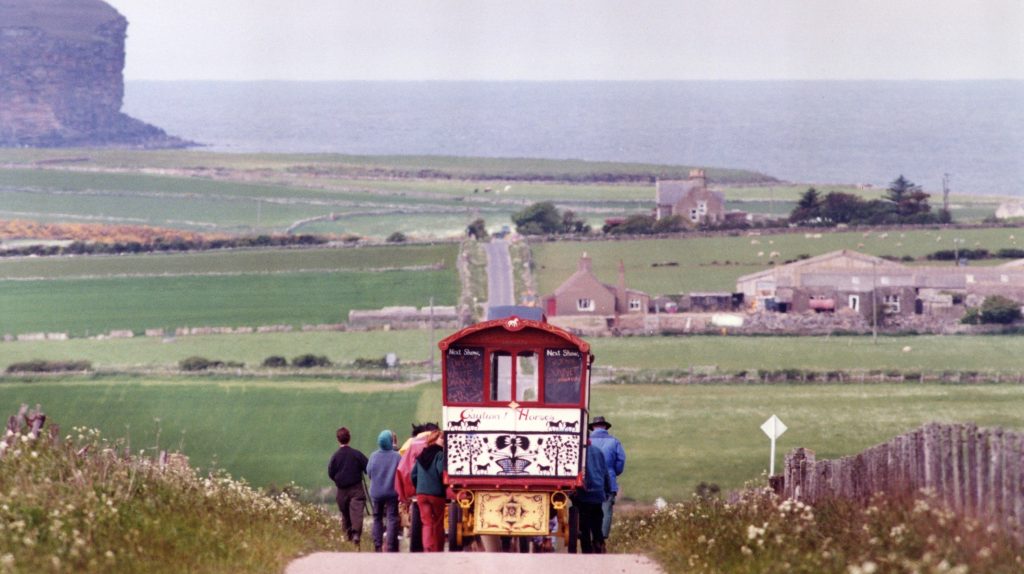The most vivid memories for me are around those moments of setting off on the days travel. This remains in the memory because much the same thing happened on alternate mornings, summer after summer, those 20 years between 1979 and 2000.
The sequence of things would vary just a little – depending, for example, on whether it was going to be a short travel day (perhaps 7 miles), or a long one (17,18) or even if it was wet and raining or sunny and dry. But generally the day started with teeth cleaning and some sort of wash, then breakfast together round the campfire – with an added sense of urgency if it was going to be a long day. Pack up your tent and load it, along with your personal bag, onto the wagon; check that the site was left clean and tidy, then make good the fire site. Finally, load the breakfast paraphernalia into the food boxes. We had two flat carts, one of which carried two food boxes, and a wagon and each of these had their own dedicated team. As the last of these jobs was being done the Horse-handler would take off with the others horse-drivers for that day to collect the animals. By preference the horses would have their own nearby paddock, but sometimes we had to share their field. If that was the case they would normally be kept on tethers.
The group very quickly mastered this routine, and things would usually come together fairly seamlessly. If anybody habitually overslept or was slow to leave their breakfast it wouldn’t be long before it was made clear that it wasn’t acceptable. Twenty plus years on, I can’t remember this actually happening, but I’m sure it must have. Our Horse-handlers were always fierce about this sort of thing, the essential discipline around the horses. I think the team-work of having already worked together on a theatre show helped massively with this. Either way, within a week or so of a tour commencing, the group could manage this morning get-away with a certain efficiency.
The carts would be loaded; their covers secured and tied down. Shafts would be attached to the carts and the horses would be given a final brush down before being harnessed. Collars over heads, then turn by 180 degrees; breeching, collar and straps adjusted. The none-horse-helpers would jump to, and lift the shafts as the horses were carefully manoeuvred, walking backwards into their embrace. The driver would be at the animals head and hold it by its bridle before asking us to attach the chain traces, which would have been crossed over the animals back, on to the shafts. This was a precise operation, measured in individual chain links, so the horse would pull the cart easily and equally on both sides. There would be a brief final check, and the Horse-handler would then say the word and off we would all go, always with some jerking – and usually at a very fast walk.
These first few minutes of the travel day would often be the most important. If harness, or a horse-shoe was to fail, then it would often be during the first 15 minutes of the day’s journey. Then, once things had settled into their stride, it became possible to relax – to a degree. The horses themselves would gradually slow down too, finding their rhythm. But it was fatal to ever totally shut-off during horse-drawn travel. You never knew, something might happen at any moment; something that would spook a horse, or damage a wagon, so staying alert was the word and for most of us it quickly became a habit.
I suppose there would, typically, be between 7 and 10 people walking alongside the horses and their carts. Each cart and wagon had its driver of course, and at least one assistant who stayed close by in case they were needed. The ‘floaters’ would keep an eye on traffic, pass drinks and snacks around, and generally enjoy the day.
We would all fall into our own rhythms alongside the horses, the click of their hooves setting the beat that we moved to. Easy to remember those fresh, sunny summer mornings and the glistening hedgerows, scolding birds, buzzing insects and smell of hay and dew. But often the walk was into driving rain, through suburbs and busy villages. On one level it was all as one. A great joy, a treat that repeated itself, an honour to take part in.



I remember the problem we had getting our cat, Mij, who came on the very first tour, to set off in the mornings She loved being in new places (oddly for a cat!) but hated having to travel in a cat box on the wagon. She would hide… and it was only when we would seriously be considering leaving her behind that she would appear from the bushes reluctantly to join the entourage. She was an amazing cat and thrived on that tour.
It was such a privilege to have been part of Horse and Bamboo albeit for just one tour!
Thanks Bob
Maggie
Mij was the only cat that I can remember ever joining us on a tour. Over the years we toured with a few dogs though…I don’t recall any of the animals being a problem. Mij arriving late to morning roll-call notwithstanding!